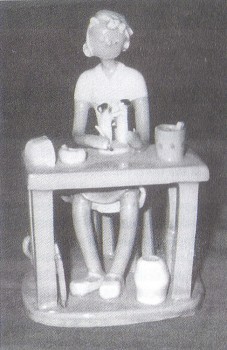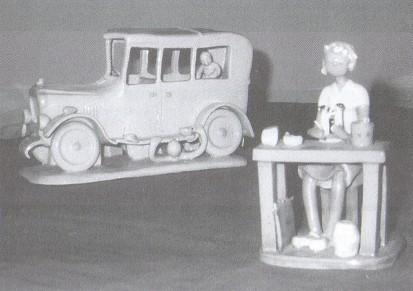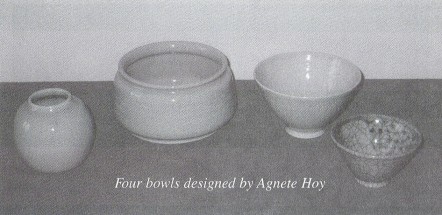BULLERS of Staffordshire -- From Insulators to Art
by Sue Taylor
Reprinted from "Crown Jewels of the Wire", August 2000, page 6
Towards the end of the 19th century the firm of Bullers Ltd. was created in
Stoke-on-Trent, Staffordshire, England. The partners in this venture had,
several years before, moved their kiln furniture manufacturing business north
from Devon to be near to the Staffordshire coal fields. Once in Staffordshire
they started to manufacture porcelain insulators as well as other products such
as door knobs, ink wells, beer pump handles and mortar and pestles. During the
early years of the twentieth century they supplied insulators for projects such
as the Adelaide tramways and Melbourne electrification in Australia; Victoria
Falls and Transvaal Power Company in Africa; and, later on, expansion of the UK
national transmission grid and the electrification of British railways. Examples
can be found in Albers' and Tod's 1982 work Worldwide porcelain insulators.
Whilst the electrical porcelain manufacturers of "The Potteries" - as
Stoke-on-Trent is known - were enjoying this boom period, the producers of
domestic and decorative wares were suffering from the economic crisis of the
post-World War I period and were seeking ways in which to once again make their
businesses profitable. The need to encourage better cooperation between art and
industry was seen as a way to produce better designs, suitable for mass
production in the new machine age and affordable to the average consumer. One of
the ways in which it was hoped to achieve this was by changing the curriculum of
art schools to meet the needs of industries such as pottery, leather and
textiles, thus creating a new generation of designers.

Anne Potts, self portrait c. 1932

Anne Potts, self portrait and Bullers company car.
The principal of the
Burslem
School of Art in Stoke-on-Trent, Gordon Forsyth, was determined to show that
this could, indeed, be achieved. He approached Bullers with a request that his
students be allowed to use their hard-paste insulator porcelain to use in
modelling small figures. Having interested Bullers and, in particular, their
glaze chemist Guy Harris whose family owned the company, he then persuaded them
to open up a small art pottery studio on the factory site in 1932. He provided
them with one of his best young pupils, Anne Potts, and she began to work in
this studio on a noncommercial basis with a small team of assistants and, with
Forsyth's backing, quickly made a name for herself amongst the art pottery
community. From this small studio an astonishing number of handmade figures,
vases and bowls were exhibited at the 1935 Exhibition of British Art in Industry
in London featuring Chinese-inspired glazes such as celadon, hare's fur and
flambe -- all the results of Guy Harris's experiments. He reportedly had a cupboard
full of rows of small insulators featuring his range of glaze experiments for
the studio pottery.
The studio closed briefly when Anne Potts left to be married
but soon reopened under the direction of Agnete Hoy and again with the support
of Forsyth and the Harris family. This time the work could be described as more
commercial and a more experienced thrower called Harold Thomas was engaged to
produce the blanks for decoration. Problems had been experienced in the early
days in coping with using the vitreous porcelain body for producing decorative
wares. It is still possible to find locally some of the items which were less
than successful -- either being too thick and heavy for practical use or having collapsed in the kiln. The products of
this second phase of studio work were marketed through the London firm of Heal's
which was renowned for its emphasis on modern design and a degree of success was
enjoyed although still not at a profitable level. A range of oven-to-tableware
was created which, had it been marketed and transferred from hand-to
machine-production, could have undoubtedly been an economic success. Sadly, this
did not happen and in spite of a successful showing at the Festival of Britain
Exhibition in 1951 when Macy's of New York expressed interest in marketing the
goods, the studio closed in 1952 and never reopened.

Many young artists passed
through the studio serving an unofficial apprenticeship both from local art
schools and farther afield. Although the standard insulator clay mixture and,
normally, the same kiln firings were used the studio essentially remained
separate from the insulator manufacturing activities. Staff did not move between
the two. The venture received high praise from proponents of the modern movement
in pottery in Britain and was seen as a bold experiment in using new materials
and methods. At the time, local people were not generally aware of its products
as they were sent to London for sale at Heal's, and much is still owned by
families of the Bullers work force who purchased it when the studio shut down.
It is still possible to find some of the ware for sale at antique fairs and
auctions and they would be of interest to porcelain insulator collectors as
examples of industrial diversification. A small exhibition of Bullers art
pottery can be seen in the Potteries Museum, Stoke-on-Trent.
Sue Taylor of Staffordshire UK is currently researching the products of the
Bullers factory in Staffordshire. If anyone knows of any similar ventures
elsewhere in the world she would be interested to hear of them. Sue can be
contacted at: s.taylor@staffs.ac.uk
|
